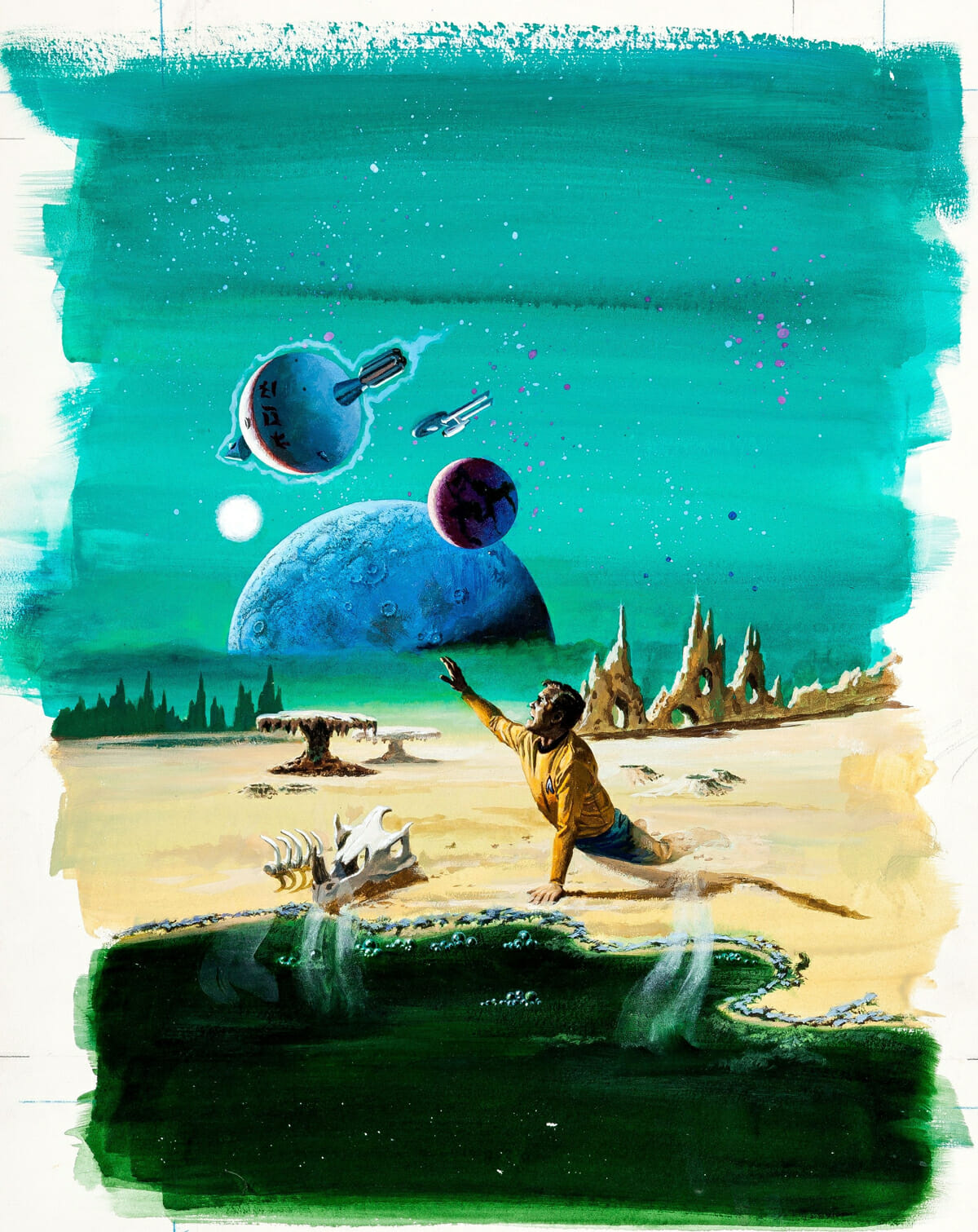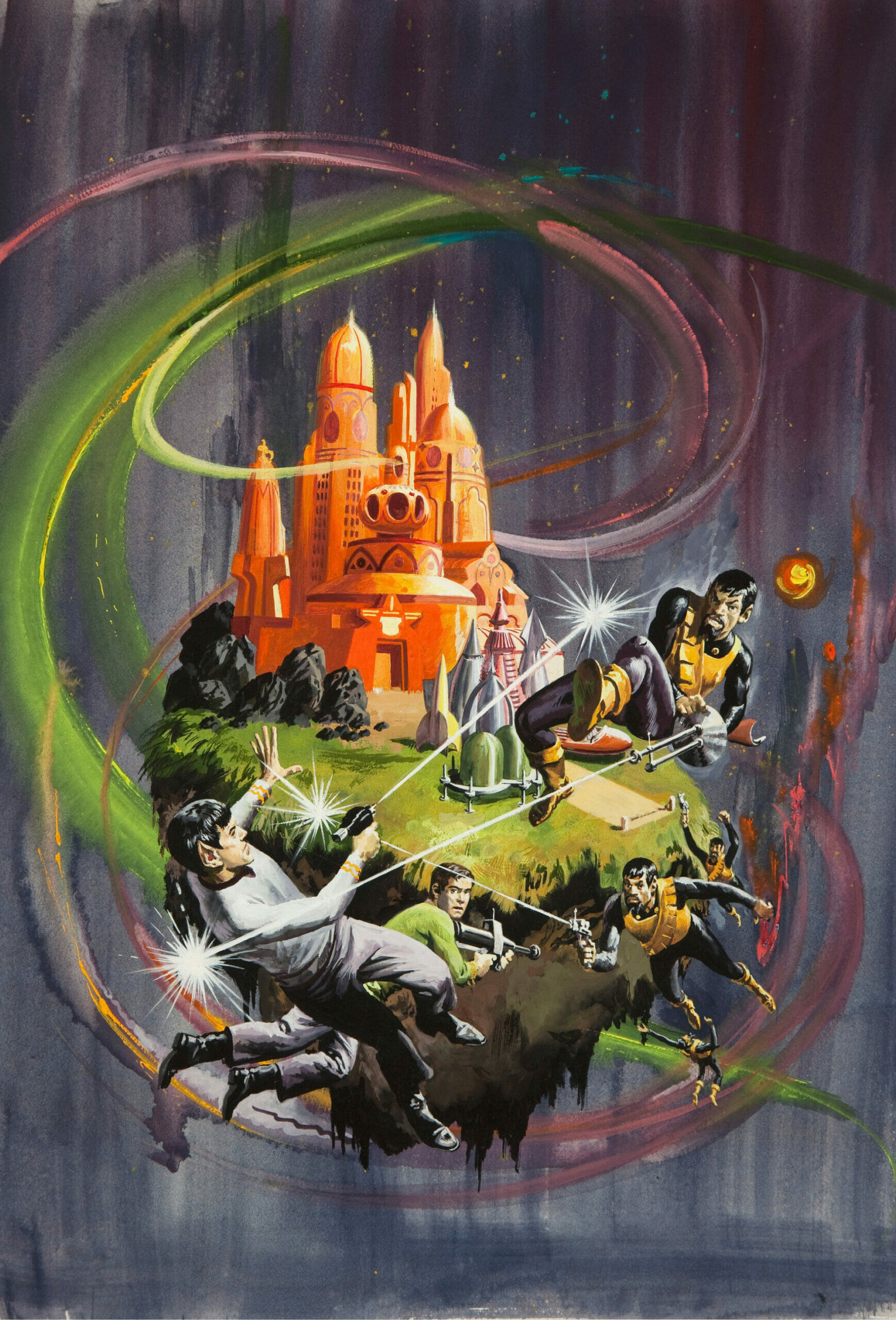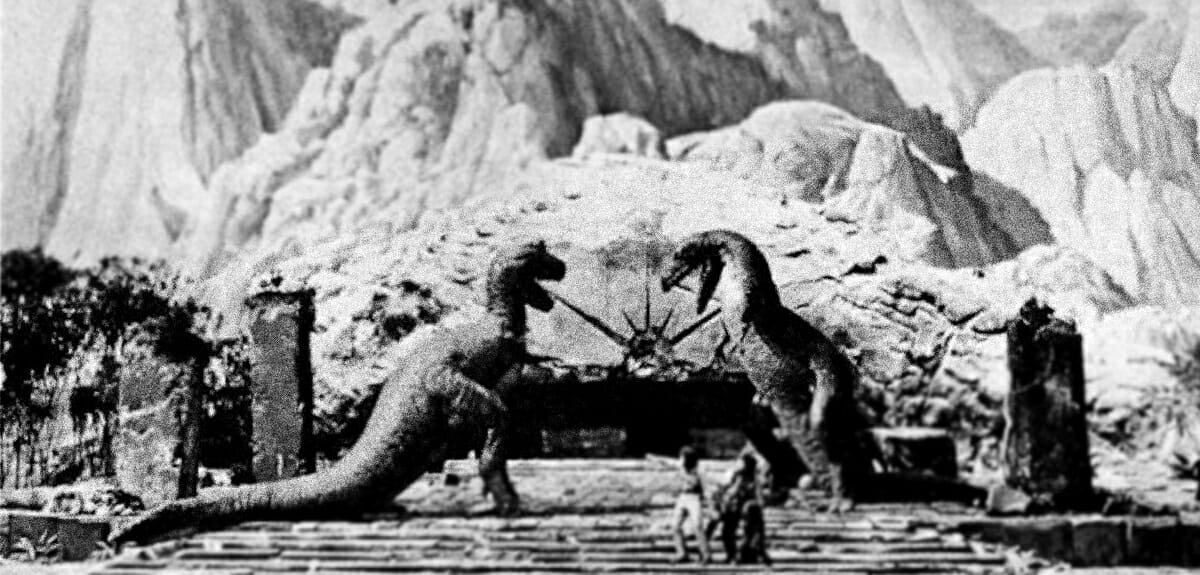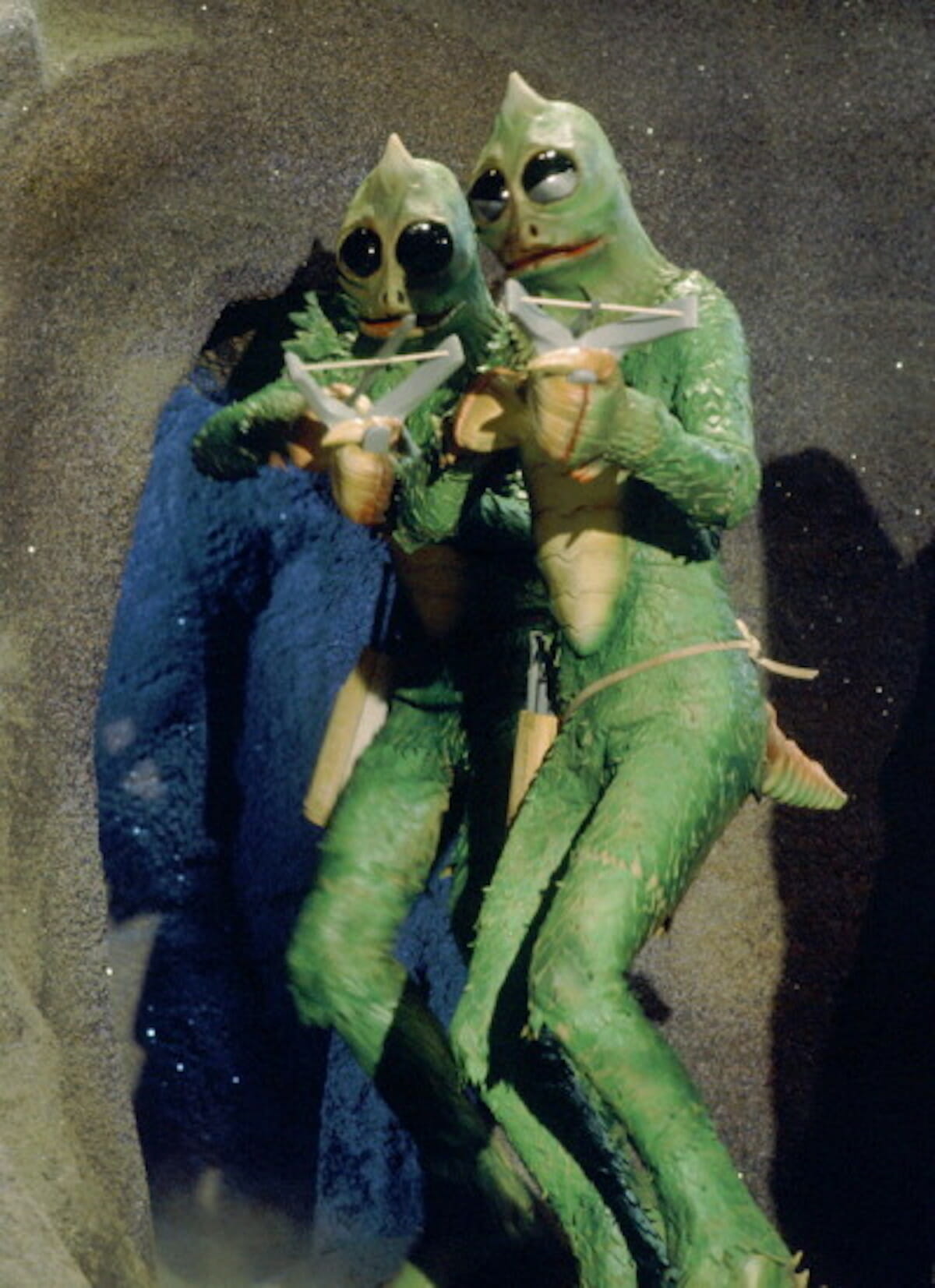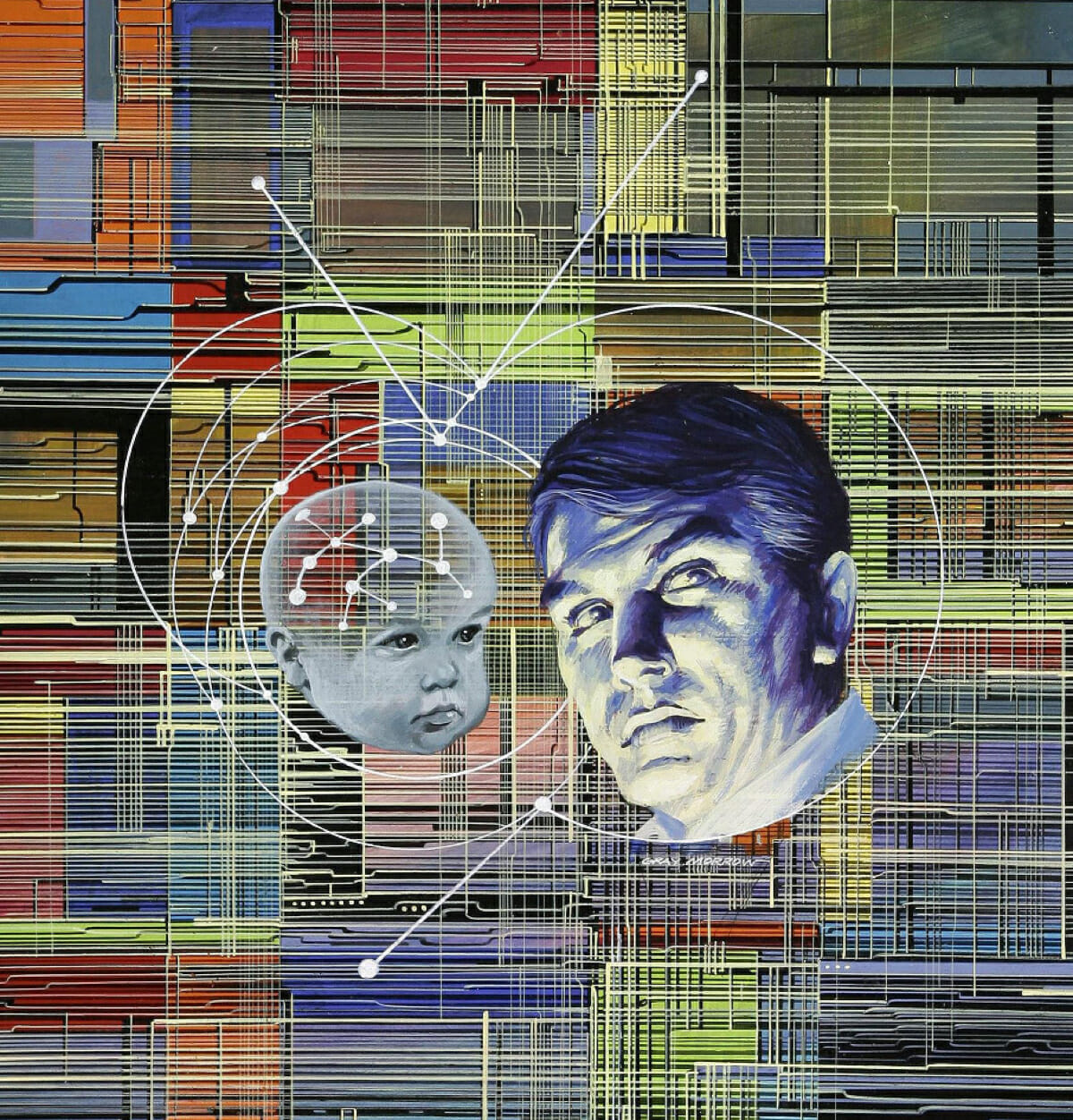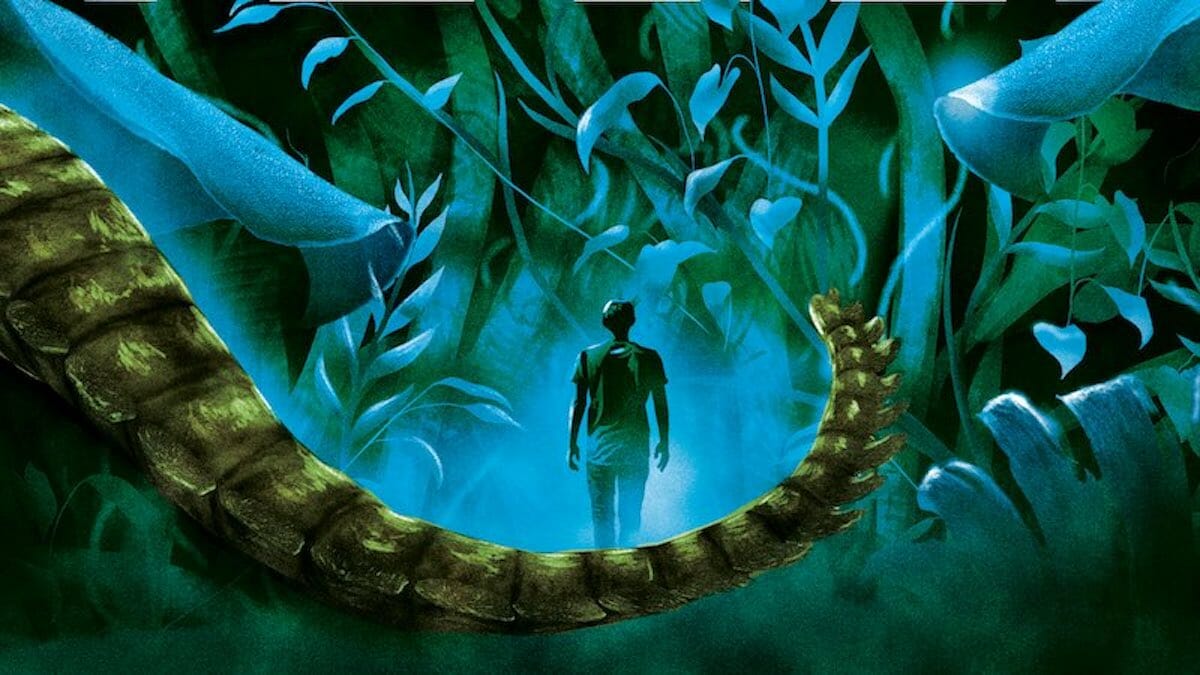If you’ve been a science fiction fan anytime within the past 50 years, whether through television or literature, chances are you’ve run across the work of David Gerrold. A writer on the original Star Trek — credited with creating the beloved episode “The Trouble with Tribbles” — as well as multi-award-winning author, and showrunner for shows such as Star Trek: The Next Generation, Babylon 5, and Land of the Lost, you can’t really throw a stone without hitting a smash hit of sci-fi influence that Gerrold hasn’t touched, and with good reason.
Getting into sci-fi thanks to a neighborhood public library and access to a bicycle, Gerrold steeped himself in the otherworldly community as a child to such an extent that there was no stopping him from becoming a pioneer in the field. As Gerrold himself puts it, “When you get your imagination stretched at an early age, it’s like the waistband on your underwear — it never goes back!” Much like his mind (and most underpants), my concept of Gerrold’s career and its impact on sci-fi and popular culture never shrank to a smaller size after our conversation either.
Gerrold started out by telling me, “When I was a kid, someone said ‘Well, you can’t know everything. Nobody’s perfect!’ But the thing is, if you say I can’t do something, then I start thinking “Oh, yes I can! Now how am I going to do it?” I’ll be honest: that quote alone could explain the length and success of Gerrolds career, and I could just stop the interview right here — but doing so would leave everyone a lot poorer.
Even from the very beginning, Gerrold seemed to never have a fear of being rejected. Initially writing fan fiction, and occasionally for fanzines, he attributes his early growth as a writer to being under the assumption that he was just writing for friends — something that allowed him to develop a chatty, friendly voice to tell his stories. It was only through attending film school that he began to really look into story structure, and through working in the Theater Arts department of his colleges that he felt he had major breakthroughs in learning both story pacing and actor directions.
“Then Star Trek came on air, and it was an act of hubris to submit stories,” he joked. “I submitted several stories and they didn’t buy anything, but [producer] Gene Coon called me in for a meeting and said they were all bought up for year one but to come back and submit more. I mentioned the Tribble episode and the first thing they said was that it sounded expensive. But I didn’t want to let go of it because I thought Star Trek needs to not save the galaxy every week.”
Luckily for Gerrold, writer and story editor Dorothy “D.C”. Fontana seemed to find a lot of promise in what was, at the time, called “A Fuzzy Thing Happened to Me…” — later famously retitled “The Trouble with Tribbles” — and decided to give him a chance, launching one of the most well-loved and well-known episodes of the Original Series to ever hit the screen.
I couldn’t help but feel like Gerrold’s youthful arrogance paid off in such a way that it looped away from being hubris at all and into something approaching a new kind of genius. Who just doesn’t accept no for an answer in a business that is so entirely ruthless that most people get turned away and never look back? The real, honest reason behind his passion was simple: Gerrold was unwilling to let viewers be subjected to another travesty like Lost in Space.
“I just didn’t want [the Star Trek producers] to do that. So I decided that I was going to submit a story that was better,” remarked Gerrold. “But by the end of the first season it was apparently that they were trying very hard to do real science fiction. Just look at the names on the credits! Harlan Ellison! Norman Spinrad! Richard Matheson! Robert Block! Theodore Sturgeon! Jerry Sohl! Max Ehrlich! They were all working on this show and it was very, very impressive.”
In addition to the other stories Gerrold contributed to the original Star Trek series (including episodes such as “The Cloud Minders” with Olivia Crawford, and “I, Mudd”), he had also begin to dabble in writing for one of my favorite period of Star Trek’s history — the short lived 1973-1974 Star Trek animated series. Though the animation was extremely limited, Gerrold was quick to comment how much more freedom there was for writers coming up with big ideas that would have been too expensive for the live-action screen.
“If I said ‘Let’s have a 500 lb Tribble in the Captain’s chair!’ then that wasn’t a problem because it didn’t cost any more to draw than anything else,” said Gerrold. “But because of the pace of animation we still had to write a complete story — a 35 or 45 page script. It was still an hour’s worth of storytelling just at a faster pace. Even though the episodes are 22 minutes long, they feel like they’re longer because we had to cram so much more story into it. There wasn’t as much room for chatter. They were more action-oriented so we had to keep them running.”
I’ll be honest — when I think of Star Trek (as I am often wont to do), I think of acceptance and an embrace of socio-cultural changes that were far before their time. Aside from daring adventures, mysterious new life forms, and the thrill of space travel, Star Trek has always stood, for me, as a beacon of goodness and hope best summed up by the fictional Vulcan philosophical adage “Infinite diversity in infinite combinations”. In other words, this show — and the things that are talked about in it — are for everyone, regardless of gender, race, religion, and sexual orientation.
Unfortunately, the team working on the show has not always been up to dealing with the inevitable backlash that comes from making the show more progressive. This topic came up after I chose to ask Gerrold about his appearance on the 30th anniversary episode of Star Trek: Deep Space Nine where he — who has been open about his sexuality as a gay man for decades — discussed the discourse of his attempt to include gay crew members on the show during the AIDS epidemic of the 1990’s.
“I did a lot of the heavy lifting for the first six months of Star Trek: The Next Generation. I wrote the bible for the show. I brought in writers to do scripts and things and then they started bringing in other people,” he said. “Gene [Roddenberry]’s lawyer came aboard and started taking apart everything that we had created. And it was a very unhappy experience. But the straw that broke my back was Gene had promised we were going to do gay characters in the crew. We were going to have a gay crew member. And he had promised it in front of an audience of 3,000 fans. And then he had said it again in a staff meeting. So I knew he was serious.”
He continued, “[Producer] Rick Berman wrote a three page memo listing all the different issue stories we could tell. And the third one on his list was AIDS. I’ve been big on blood donations because of my friendship with Robert A. Heinlein, and so I said I wanted to do a story about how the fear of AIDS has cut back blood donations. So the story was about a disease, some of the crew members were infected, and the only way to save their lives, was to donate blood because they had run out of artificial blood. The show could put a card at the end of the episode saying ‘You can be a hero, too. Go and donate blood.’ I thought that if we did that then the next day, the next week, blood donor-ship would go up 100% because all of the Trekkies would run out [to donate blood]. And Star Trek would get credit for it. It would have been good publicity for the show, but it would also save human lives. I thought it was perfect. That’s Gene Roddenberry’s universe.
So by the time I got to the script, they approved the outline and I said ‘Oh, you know what? These two characters, they’re boyfriends! Or married! Or whatever!’ And so there’s four lines of dialogue in the script. — ‘How long have you two been together?’ ‘Since the academy.’ — That’s it! Now, if you’re under 12 — ‘Oh, they’re good friends!’” And if you’re older than that, you realize, ‘Oh my gosh, they just put gay crew members on this.’ So you might say ‘hooray!’ but it created an uproar of biblical proportions. As you would say, in Ghostbusters — ‘dogs living with cats’.”
Gerrold went on to tell me about a follow up memo that he had received, saying that he had to take the gay characters out of the show due to the threats and angry letters from mothers that they were bound to receive, to which Gerrold responded in the best way: ”Let them write letters then! The Streisand Effect is free publicity!”
“We went through two or three different rewrites and the script didn’t get any better. [Producer] Bob Justman finally realized that we needed to go back to my original draft, but by then it was too late,” he remembered. “That made me realize that if we didn’t do that script then not only is Gene a hypocrite, but I’m also a hypocrite for staying aboard this show when we’ve broken a promise and I let them straight-wash my script. If I do that, then I’m not doing what Star Trek is supposed to do.”
As a queer Trekkie, this portion of the conversation could not have made my heart more full. Though the disagreement on Gene Roddenberry’s end ultimately led to Gerrold leaving writing for Star Trek for good, he maintains that it was one of the best decisions that he could have made.
“I made up my mind around 1988 or 1989 that I was going to spend the next ten years writing the best books I could. But one of the things that happened was I realized there was one thing on my bucket list that I had not done: I wanted to adopt a little boy,” Gerrold warmly remembered.
Gerrold explained that after leaving Star Trek, which he still laudes as being one of the best things to happen for his personal and professional growth, he made the proper efforts to get his house, finances, and parenting research in order so that he could be approved to adopt. In the middle of this process, writing a book was the last thing on his mind — but after the nerves of the process and the match being so seamless for him and his son Sean, a book just kind of…happened, and Gerrold began writing one of my favorites in his roster of titles: 1994’s The Martian Child.
“They didn’t expect the adoption to succeed, but I’m not a quitter and neither was he. We were just about as good a match as you could ask for. He was eight then and he’s thirty-six now with a beautiful wife and a baby on the way. I think I got my job done,” said Gerrold, clearly proud of his son. “Some people complained that I didn’t talk about Sean’s issues in greater depth [in The Martian Child], but why would I violate his privacy? The story was not about him so much as it was about the development of our relationship. And when I was qualifying [for adoption] the case worker asked me if I was planning on writing a book and I said no! But then, one night two or three months after he moved in with me, I was feeling so good about how things were going that I tucked him into bed and wrote the novella of The Martian Child in one sitting. It was sloppy and disjointed, but the passion was there. The punchline works so that essentially it doesn’t matter if he’s a martian— he’s mine. It was rejected a half a dozen times before Kristine Kathryn Rusch at Fantasy and Science Fiction bought it. Next thing I knew it was winning awards everywhere!”
The joy of The Martian Child didn’t stop there for Gerrold, as the movie rights for the novel were picked up by Meridian Zweite Productions, with the eventual adaptation starring John Cusack released in 2007. Unfortunately for Gerrold, this meant screenwriters taking liberties with his story, going so far as to make his semi-autobiographical character, played by Cusak, into a heterosexual widower instead of a single gay man.
“The movie grabs large parts of the novel and the script that I wrote, but one of the producers called me and asked if I was concerned about getting backlash about my character being gay and I told him that he was going to be the one getting the backlash. He asked why and I had to explain to him how he straight-washed my character and that he would get killed in the reviews for doing it. He said ‘no no no no’, but what do I know about movies, right? The reviews that I did track down — maybe 30 or 40 or so — the folks who were aware of the book complained about the straight washing. They felt cheated and I was like…well, duh!”
For those of you not on board with adorably wholesome novellas — or those who never got on board the Star Trek train — there are, still, a few things that you loved from your childhood that can likely be credited to Mr. Gerrold as well. If you were one of the millions of wide-eyed kids who cozied up around the TV on Saturday mornings to watch Land of the Lost, for example, I have some news for you.
“For Land of the Lost, I functioned like a showrunner,” Gerrold recalled. “I invented the lizard people which I called the Sleestaks, and I took out the giant insects and put in the Lost City. But I wanted to keep the family and the dinosaurs because… well, I love dinosaurs!”
As uncredited showrunner on the beloved kids’ show, which ran from 1974 through 1976, Gerrold managed to utilize a lesson he’d learned from his earlier hit. “I did a trick,” he admitted. “The best Star Trek episodes were written by science fiction writers so I called up every good sci-fi writer I knew who could do script format. If you look at the writing credits for Land of the Lost you’ll see Star Trek writers and science fiction writers like Walter Koenig, Ben Bova, Norman Spinrad, Dorothy Fontana, Larry Niven.”
Being a kid who grew up watching reruns of old TV shows, I couldn’t help myself in telling Gerrold that the Sleestaks were something that genuinely scared the bejeezus out of me as a kid. The irony being, the Sleestaks never really… did anything. They were very tall and had massive eyes, sure, but for the most part, they just bumbled around and never truly posed a threat to the family in the show. Apparently, this was something entirely planned and accounted for, and gave Gerrold a bit of a laugh when I brought it up.
“They were three basketball players from [University of Southern California]!” Laughed Gerrold. “They were already very tall, but then we put them on foot-high boots and built the tops of their heads with crests. So when you met a Sleestak, they were nine feet tall. It was developed pretty damn close to what I imagined we could do, but I wanted the eyes to be even bigger like The Fly, but that was okay. The guys have to be able to see. They were really good guys, though. It was hard to be scared of one you knew who was in the suit.”
Aside from Land of the Lost, this period of his career also features credits on powerhouse sci-fi hits like The Twilight Zone, and several science fiction novels. Reader, I don’t know about you, but that amount of work would crush me over such a subjectively short period of time, but apparently it was just another exciting day at the office for Gerrold, who seemed happily stuck in an infinite loop of work, eat, sleep, repeat.
“I would say it was an exciting period,” he remembered. “We had just moved into the soundstage at Goldwyn Studios and we were going to do three weeks of Sigmund and the Sea Monsters and refit the sets from Land of the Lost, but of course they caught fire. We lost the soundstage and had to rebuild everything we lost before we could get reestablished. One we did, we managed to hit our deadlines and get our work done. But a lot of that was a period where I was so busy that it was a lot of wake up, drive in, type, type, type, type, go home, fall asleep. And in the middle of that I was renting a house, found out that I was going to lose the house, and some real estate agents knocked on my door and told me I was going to go buy a house! I wrote a check and started to worry about payments, but then the royalty checks from my Star Trek books started coming in and I didn’t have to worry about the downpayment so much anymore! 1974 was a very interesting year all around. I went from feathers to chickens very fast.”
And chickens he indeed had, because come the Nebula Awards 1974, Gerrold also found himself nominated for the Hugo Awards for Best Novel with his time-travel adventure The Man Who Folded Himself, a novel playing with the idea of time travel and growth. According to Gerrold, however, getting the point where the novel would be remembered 40 years later is something that didn’t come as easy as some of his other projects.
“I reached a point where I didn’t know what I was going to do next. I gave it to my agent to see if he could sell it. I started the first fourteen chapters of The Matter for Men and was happy writing it; but then my agent called me and said he had sold The Man Who Folded Himself to Random House and I was like… ‘well shit, now I have to finish it!’” laughed Gerrold. “So I sat down with it and would write three pages before thinking I had no idea what would happen next. The book was written by way of thinking that I had no idea what was going to happen next. Now, the book has been in print for about 40 years and continues to sell really well and I’m a bit startled by that because I thought When Harley was One was a much more ambitious book. But The Man Who Folded Himself is really an imagination-stretcher because the two things I hear from people is that the book saved their life because they thought they were alone until they saw that the hero was gay; and that the book blew their mind with all the different possibilities postulated because the hero goes to the beginning of time, the end of time, and play around with a lot of time. He has all of these opportunities in front of him and all of these choices and really — for most of the book — he’s just a naive little dweeb! But the end of the book is him accepting responsibility. It’s a story about growth.”
That’s one thing that seemed incredibly common during our conversation: the topic of growth — on a personal level, on a professional level, on a character-driven level. Or even Gerrold’s ability to turn growth into something entirely horrifying and other-worldly through the application of ecology in alien invasion. I suspect that many people deep into the sci-fi scene have clicked onto this article because they’re obsessed with the 37-year-strong The War Against the Chtorr series, and I had to ask Gerrold about what it was like to have a series that has lasted almost four decades.
Gerrold insists that the story was only meant to be a trilogy, but the growth of the story is what has propelled it into the science fiction hall of fame, and is responsible for its lengthy run. While many sci-fi stories are based on the immediate horrors of fire, brimstone, destructive technology, and vile experimentation, The War Against the Chtorr series — with original covers by artist Boris Vallejo– has continued to keep readers captivated through the menacingly slow burn of a more realistic colonization narrative.
“That was the breakthrough for me! You don’t invade a planet with all your machines and burn down everything. That’s just creating an ecological nightmare. The best example is the European settlers colonizing North America, South America, Africa, Australia. What did they do? They took their rabbits, sheep, goats, cows, horses, and honeybees. They took all the things that they wanted to eat! So if you’re going to invade a planet, you don’t invade a planet— you colonize it from the ground up,” said Gerrold. “First you go in with your fungi, because that’s what your plants have to live on. Then your microbes, and next up is your small critters. Then the ones that feed on them, and then the ones that feed on them and finally you get to the apex predators at the top of your food chain. And then everybody’s asking who’s in charge of this ecology? And that was the other breakthrough —nobody’s in charge of the ecology; the ecology invaded. The seeds were planted, and if there’s an intelligence behind it then it hasn’t appeared yet. And the realization is that the intelligence in the Chtorran ecology is an emergent behavior.”
It was clear that the deeper connotations of world-building was not something unusual for Gerrold to think about when tackling a new novel (or continuing a series), as he expressed his love of nature documentaries and books about dinosaurs to me. “Everything for a reason and everything with purpose” seemed to be a common theme, so while I was thrilled and itching to talk to him about his latest novel from DAW Books, Hella, it wasn’t a surprise that everything that seemed so unprecedentedly charming and innovative to me was something that was carefully considered and even more carefully crafted. Much like his other, earlier books, Hella is born from one part life experience, one part a way to help people learn, and one part thirst for stellar adventures.
“I was an awkward kid, right? And they’d had the terms then they might have said I was on the [autism] spectrum or might be ADHD. I think brain development is just weird. And I wanted to continue the Dingilliad trilogy, but I didn’t want to spend any more time with Charles because his story was done. So I thought that I’d tell it from the point of view of the colonists and that way I get to see the dinosaurs firsthand! That was the first thing I did is take readers out for a ride along and go look at the dinosaurs first hand. Then we get the word that the starship is arriving. I had written, I don’t know, maybe a third of the book and it suddenly occurred to me that [the novel’s protagonist] Kyle is not the average child hero. He is somewhere on the spectrum! And he’s got a chip in his head which allows him to function because it gives him information! And I thought that nobody’s made this,” said Gerrold, brightly.
“There’s this book, [Mark Haddon’s 2003 mystery novel] The Curious Incident of the Dog In the Nighttime, and I was so impressed by how the author had done this incredible looking at the world through the eyes of this autistic child. I thought about how I would love to be able to write that kind of a story; not that story, but that kind of story,” he continued. “It occurred to me that every reader out there who is on the spectrum is suddenly going to say, ‘Here’s a book where I’m the hero.’ And it’s the same thing that with gay kids have said for the longest time they were reading science fiction, and they were invisible. They weren’t in any of the science fiction worlds until The Man Who Folded Himself. That feeling of not being alone. And so, it occurred to me that Kyle is for all of the kids and young readers and teenagers who have wanted to be part of the science fiction universe and nobody has written them in! So for me it was a breakthrough moment to realize what I’m doing here. In making Kyle this kind of a protagonist, I am saying to my audience that I recognize you’re out there.”
Gerrold talked about how much research he did when looking into writing Kyle as a neurodivergent character, including the experience he’d had as a child, as well as his experiences with his autistic nephew, and research done when adopting his son Sean. Though some readers have objected, suggesting that Gerrold has been insensitive to take a smattering of characteristics together for his character’s development, he remains adamant that his work of fiction was meant to try and reach as many young adults who could identify with Kyle as possible.
This resonated with me in particular because of my school-age son, who is in the beginnings of being tested. When I read Hella, there was something very special about Kyle and how the character was not devoid of empathy or emotion in the way that many pop culture stories make all autistic people out to be. He had compassion and a sense of caring… just with a little less nuance; especially considering that Kyle also, as Gerrold said, has an implanted chip in his brain which he refers to as “the noise,” feeding him information and knowledge about things he doesn’t understand. This struck home for me particularly, as whenever my son has had difficulty focusing receiving information, we also refer to it as “the noise.” My son was elated that someone understood, and that the character — even if he was fictional — also knew what having a “noise” meant. Telling this to Gerrold, he was happy to hear that while DAW books doesn’t publish fiction for kids, that it was reaching its originally-intended audience.
While there’s plenty to be said for the subtleties and details that Gerrold includes in Hella, there was another part that stuck out like a beacon despite being delightfully nonchalant in the telling, and that’s the notion that the changing of gender or the changing of sex is as easy as making the decision to do so. Even Kyle — who identifies as male and uses he/him pronouns throughout the novel — makes a small reference to “when he was a girl,” with another mention elsewhere to when his mum decided she wanted to be a girl so she could have Kyle and his brother. Although it’s a very small aside that purposefully carries no weight to it, the inclusion was something refreshing to see in an otherwise gender-strict genre of fiction, I said.
“Part of the research I had been reading about is people who are dealing with their kids announcing their real gender as young as age five or six, and that they start living as male or female because that’s who they feel. And they’re happier! They’re meant to be that way! So casually mentioning it and not making a big deal out of it was a way to be like yes, you’re here, too,” said Gerrold.
“The status quo is the enemy. And science fiction is about looking to the stars, but it’s also about looking inside,” he continued. “It’s about what we can explore! It’s literally seeking out new life, and the greatest adventure is the human adventure. Who are we? What is our place in the universe? What does it mean to be a human being? What can we do with this human body that we have? How can we be better? How can we be a better species? What’s possible in this universe? And that’s the essential question of science fiction: what’s possible and what’s next? I started out writing this one as it was just going to be an adventure story and it ended up being a lot more than that because I started asking more questions. And I think when a writer starts asking more questions, they start to get to the heart and soul of the human condition.”
The importance of updating one’s point of view — especially when that person is putting creativity out into the world — cannot be overstated, and it seems that Gerrold has done exactly that: going to great lengths in terms of research to make sure that science fiction — once a niche corner of the publishing world — is now something to be identifiable and read by anyone who chooses to. Even after over fifty years of turning out countless examples of thrilling world-building and adventure, Gerrold is happy to carry on learning and pushing the boundaries as long as he can.
“You write what you love, but you also have to do the research. Write what you know? Forget that. No, write what you love and do the research to make it work,” concluded Gerrold. “The status quo is the enemy. Challenge it.”
